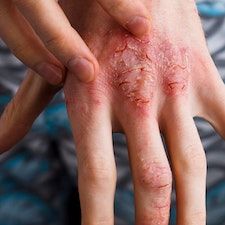News
Article
Continuous Upadacitinib Treatment of Atopic Dermatitis Suggested to Ensure Maintenance of Skin Clearance
Author(s):
In this latest research, the investigators noted that upadacitinib therapy may also be utilized as a treatment option for atopic dermatitis patients who experience a flare.

Discontinuation of upadacitinib followed by reintroduction for adults with moderate-to-severe atopic dermatitis (AD) leads to diminished results followed by rapid recovery of both skin and itch responses, according to recent findings, indicating continuous upadacitinib treatment’s potential.1
The findings resulted from new research examining the effects of withdrawing from upadacitinib on patients’ skin clearance as well as improvement in pruritus for adult patients with moderate-to-severe atopic dermatitis. The study’s investigators also sought to assess the kinetics of recovery on patients’ rescue treatment.
The new research was authored by Emma Guttman-Yassky, MD, PhD, from the Department of Dermatology at the Icahn School of Medicine at Mount Sinai, New York, NY.
“The objective of this analysis was to assess the effect of withdrawal on skin clearance and itch improvement in patients with AD, and to evaluate the effect of rescue treatment with upadacitinib in patients who experienced loss of efficacy,” Guttman-Yassky and colleagues wrote.
Background and Findings
In this latest study, the investigators reported on findings from their post-hoc analysis of the randomzied, phase 2b, placebo-controlled trial examining upadacitinib in those with diagnosed moderate-to-severe eczema. The team noted that the drug’s data has shown rapid improvement in itch in both this study as well as other trials.2,3
Regarding the initial study’s design, the first 16-week phase of the 88-week study was carried out over 8 total countries with adult study participants facing atopic dermatitis who had experienced inadequate control from topical therapy being enrolled in the research. The investigators had used a double-blind, parallel-group, placebo-controlled study design, with participants being randomly assigned in a ratio of 1:1:1:1, using an interactive response system as well as a geographical stratification.
The investigators treated participants with either a daily oral monotherapy of upadacitinib at doses which were 7.5 mg, 15 mg, or 30 mg, or they treated participants with placebo. The research team’s primary endpoint was decided to be the percentage enhancement in the Eczema Area and Severity Index (EASI) from the point of baseline, which the team determined at the 16 week mark.
The investigators’ examination of efficacy covered all randomized participants on an intention-to-treat basis. The team based their safety evaluations on all randomized participants who had actually been given the study medication.
After the initial 16-week interval—known as Period 1—a subsequent 72-week phase was decided to be Period 2, which at the time involved participants being re-randomized at a 1:1 ratio to either continue their upadacitinib dosage or to be given a placebo within each dosage arm.
Additionally, the research team noted that the participants who were first assigned to the placebo arm were re-randomized to be given either upadacitinib 30 mg or a placebo. For the total duration of the team’s 72-week period, participants showing lower than 50% improvement in EASI scores relative to their baseline values were treated with rescue therapy with upadacitinib 30 mg in a blinded manner, and the team added that commencement was at 4 weeks following re-randomization.
Overall, the investigators found that those who ceased upadacitinib therapy showed a quick decline in their skin clearance responses, but those who were shown to have transitioned from receiving a placebo to upadacitinib showed an improvement in their responses. Furthermore, the research team noted the appearance of loss of skin clearance response within a time frame of 4 weeks, followed later by aggravated itch within 5 days.
Among the adult patients initially given either a placebo or a lower upadacitinib dose that led to an EASI response reduction, administering rescue treatment using upadacitinib 30 mg was shown to have led to swift reinstatement or enhancement of both skin as well as itch responses. The majority of participants who were re-randomized to the placebo arm were shown to have gotten an EASI score of 75 and IGA rating of 0/1 in the time span of 8 weeks of rescue treatment, and no novel safety concerns were found by the team.
“Patients who are non-adherent or stop therapy may lose skin clearance and itch response rapidly given the short half-life of upadacitinib,” they wrote. “Although Phase 3 studies were only conducted using continuous treatment, upadacitinib may also be a treatment option for AD patients experiencing a flare.”
References
- Guttman-Yassky, E., Silverberg, J.I., Thaçi, D., Papp, K.A., Ständer, S., Beck, L.A., Kim, B.S., Hu, X., Liu, J., Calimlim, B.M., Vigna, N., Crowley, J.T., Teixeira, H.D. and Thyssen, J.P. (2023), Upadacitinib treatment withdrawal and retreatment in patients with moderate-to-severe atopic dermatitis: results from a phase 2b, randomized, controlled trial. J Eur Acad Dermatol Venereol. Accepted Author Manuscript. https://doi.org/10.1111/jdv.19391.
- Guttman-Yassky E, Thaçi D, Pangan AL et al. Upadacitinib in adults with moderate to severe atopic dermatitis: 16-week results from a randomized, placebo-controlled trial. J Allergy Clin Immunol 2020; 145: 877-884.
- Reich K, Teixeira HD, de Bruin-Weller M et al. Safety and efficacy of upadacitinib in combination with topical corticosteroids in adolescents and adults with moderate-to-severe atopic dermatitis (AD Up): results from a randomised, double-blind, placebo-controlled, phase 3 trial. Lancet 2021; 397: 2169-2181.





